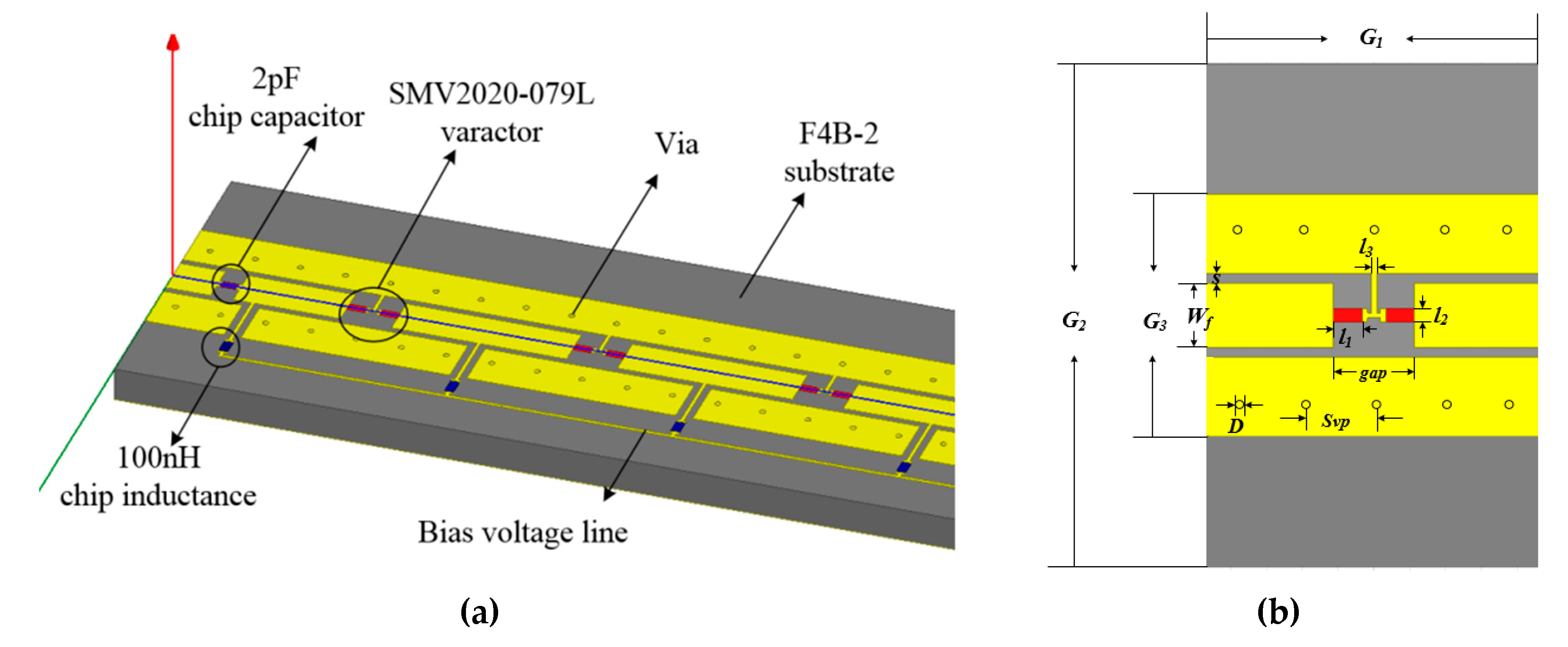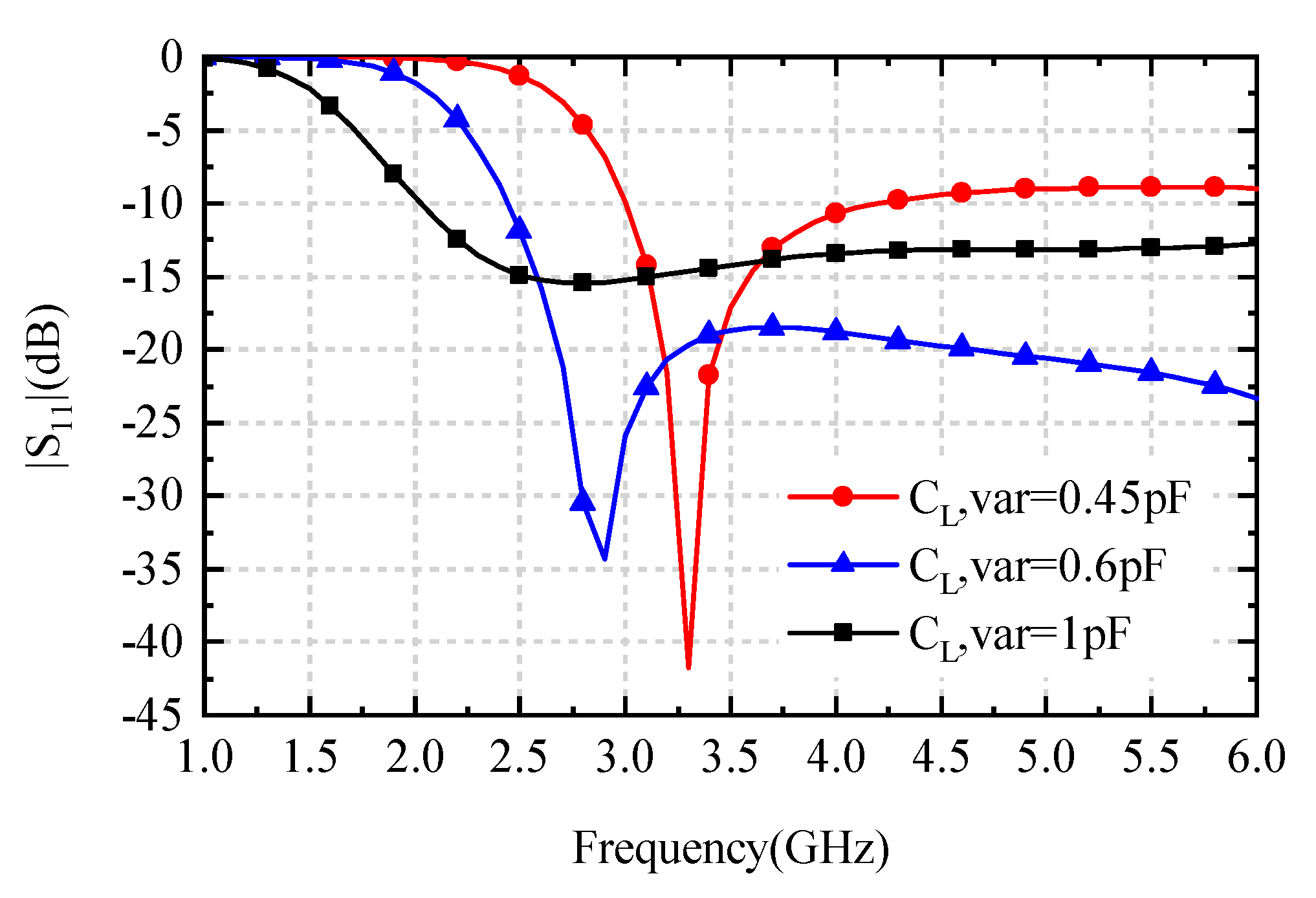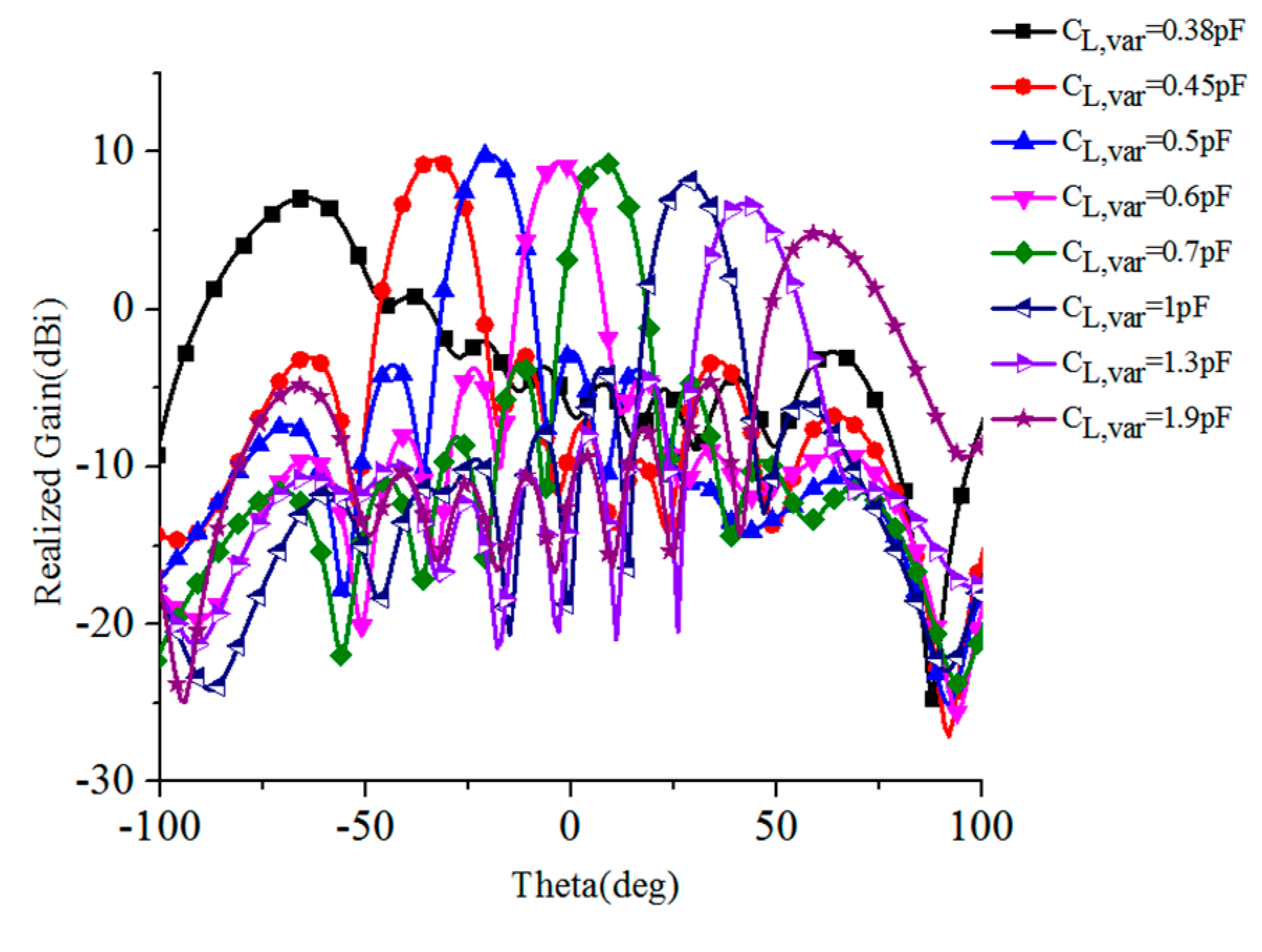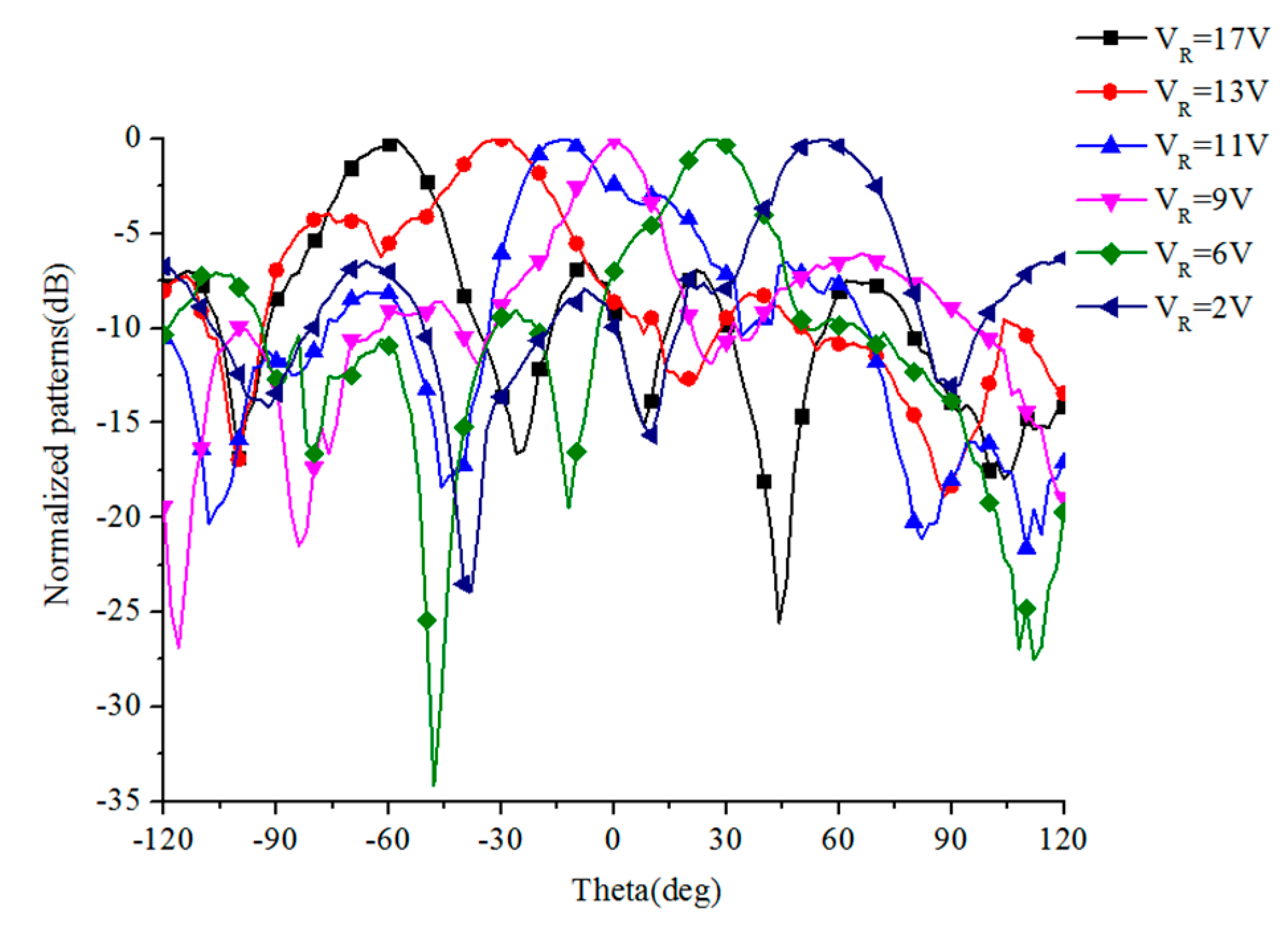A Wide-Angle Scanning Leaky-Wave Antenna Based on a Composite Right/Left-Handed Transmission Line
Abstract
1. Introduction
2. Operation Principle and Scheme of the Proposed LWA
2.1. OperationPrinciple
2.2. Proposed LWA Configuration
3. LWA Design and Experiment Results
3.1. Simulated Results for the Unit Cell
3.2. Simulated Results of the LWA with Finite Unit Cells
3.3. Fabrication and Measurement
4. Conclusions
Author Contributions
Funding
Conflicts of Interest
References
- Oliner, A.A. Leakage from higher modes on microstrip line with application to antennas. Radio Sci. 1987, 22, 907–912. [Google Scholar] [CrossRef]
- Jackson, D.R. Leaky-wave antennas. In Frontiers in Antennas: Next Generation Design &Engineering; Caloz, C., Jackson, D.R., Itoh, T., Eds.; McGraw-Hill: New York, NY, USA, 2011; pp. 339–406. [Google Scholar]
- Liu, J.; Jackson, D.R.; Long, Y. Substrate Integrated Waveguide (SIW) Leaky-Wave Antenna with Transverse Slots. IEEE Trans. Antennas Propag. 2011, 60, 20–29. [Google Scholar] [CrossRef]
- Shelby, R.A.; Smith, D.R.; Schultz, S. Experimental Verification of a Negative Index of Refraction. Science 2001, 292, 77–79. [Google Scholar] [CrossRef] [PubMed]
- Caloz, C.; Itoh, T. Electromagnetic Metamaterials: Transmission Line Theory and Microwave Applications; Wiley: Hoboken, NJ, USA, 2005; pp. 261–313. [Google Scholar]
- Eleftheriades, G.V.; BalmainK, G. Negativere Fraction Metamaterials: Fundamental Principles and Applications; Wiley: Hoboken, NJ, USA, 2005; pp. 53–92. [Google Scholar]
- Sanada, A.; Kimura, M.; Awai, I.; Kubo, H.; Caloz, C.; Itoh, T. A planar zeroth order resonator antenna using left-handed transmission line. In Proceedings of the 34th European Microwave Conference, Amsterdam, The Netherlands, 12–14 October 2004. [Google Scholar]
- Caloz, C.; Sanada, A.; Itoh, T. A novel composite right-/left-handed coupled-line directional coupler with arbitrary coupling level and broad bandwidth. IEEE Trans. Microw. Theory Tech. 2004, 52, 980–992. [Google Scholar] [CrossRef]
- Dong, Y.; Itoh, T. Substrate integrated composite right-/left-handed leaky-wave structure for polarization-flexible antenna application. IEEE Trans. Antenna Propag. 2012, 60, 760–771. [Google Scholar] [CrossRef]
- Cao, W.; Chen, Z.N.; Hong, W.; Zhang, B.; Liu, A. A beam scanning leaky-wave slot antenna with enhanced scanning angle range and flat gain characteristic using composite phase-shifting transmission line. IEEE Trans. Antennas Propag. 2014, 62, 5871–5875. [Google Scholar] [CrossRef]
- Yang, Q.; Zhao, X.; Zhang, Y. Composite right/left-handed ridge substrate integrated waveguide slot array antennas. IEEE Trans. Antennas Propag. 2014, 62, 2311–2316. [Google Scholar] [CrossRef]
- Nasimuddin; Chen, Z.N.; Qing, X. Multilayered composite right/left-handed leaky-wave antenna with consistent gain. IEEE Trans. Antennas Propag. 2012, 60, 5056–5062. [Google Scholar] [CrossRef]
- Saghati, A.P.; Mirsalehi, M.M.; Neshati, M.H. A HMSIW circularly polarized leaky-wave antenna with backward, broadside, and forward radiation. IEEE Antennas Wirel. Propag. Lett. 2014, 13, 451–454. [Google Scholar] [CrossRef]
- Huang, L.; Chiao, J.-C.; De Lisio, M. An electronically switchable leaky wave antenna. IEEE Trans. Antennas Propag. 2000, 48, 1769–1772. [Google Scholar] [CrossRef]
- Ouedraogo, R.O.; Rothwell, E.; Greetis, B.J. A reconfigurable microstrip leaky-wave antenna with a broadly steerable beam. IEEE Trans. Antennas Propag. 2011, 59, 3080–3083. [Google Scholar] [CrossRef]
- Karmokar, D.K.; Esselle, K.P.; Hay, S.G. Fixed-Frequency beam steering of microstrip leaky-wave antennas using binary switches. IEEE Trans. Antennas Propag. 2016, 64, 2146–2154. [Google Scholar] [CrossRef]
- Sajin, G.; Simion, S.; Craciunoiu, F.; Muller, A.; Bunea, A.C. Frequency tuning of a CRLH CPW antenna on ferrite substrate by magnetic biasing field. In Proceedings of the 39th European Microwave Conference, Rome, Italy, 28–29 September 2009; pp. 1283–1286. [Google Scholar]
- Che, B.-J.; Jin, T.; Erni, D.; Meng, F.-Y.; Lyu, Y.-L.; Wu, Q. Electrically controllable composite right/left-handed leaky-wave antenna using liquid crystals in PCB technology. IEEE Trans. Components Packag. Manuf. Technol. 2017, 7, 1331–1342. [Google Scholar] [CrossRef]
- Lim, S.; Caloz, C.; Itoh, T. Metamaterial-based electronically controlled transmission-line structure as a novel leaky-wave antenna with tunable radiation angle and beamwidth. IEEE Trans. Microw. Theory Tech. 2005, 53, 161–173. [Google Scholar] [CrossRef]
- Suntives, A.; Hum, S.V. A fixed-frequency beam-steerable half-mode substrate integrated waveguide leaky-wave antenna. IEEE Trans. Antennas Propag. 2012, 60, 2540–2544. [Google Scholar] [CrossRef]
- Fu, J.-H.; Li, A.; Chen, W.; Lv, B.; Wang, Z.; Li, P.; Wu, Q. An electrically controlled CRLH-inspired circularly polarized leaky-wave antenna. IEEE Antennas Wirel. Propag. Lett. 2016, 16, 760–763. [Google Scholar] [CrossRef]
- Lee, N.; Lee, S.; Cheon, C.; Kwon, Y. A two-dimensional beam scanning antenna array using composite right/left handed microstrip leaky-wave antennas. In Proceedings of the 2007 IEEE/MTT-S International Microwave Symposium, Honolulu, HI, USA, 3–8 June 2007; pp. 1883–1886. [Google Scholar]
- Kaneda, T.; Sanada, A.; Kubo, H. Design of an 8-element planar composite right/left-handed leaky wave antenna array for 2-D beam steering. In Proceedings of the 2006 Asia-Pacific Microwave Conference, Yokohama, Japan, 12–15 December 2006; pp. 1067–1070. [Google Scholar]











| G1 | G2 | G3 | Wf | S | Svp |
| 20 | 31 | 15 | 4 | 0.6 | 4 |
| D | gap | l1 | l2 | l3 | |
| 0.5 | 4.5 | 1.6 | 0.8 | 0.3 |
| 5 V | 10 V | 15 V | 20 V | |
|---|---|---|---|---|
| CL,var(pF) | 1.19 | 0.57 | 0.41 | 0.35 |
| LL(nH) | 1.82 | 1.53 | 1.01 | 0.77 |
| CR(pF) | 1.95 | |||
| LR(nH) | 9.78 | |||
| Ref. | Simulated Scanning Range | Measured Scanning Range | Overall Length | Realized Gain (dBi) |
|---|---|---|---|---|
| [21] | −38°–+30° | −17°–+40° | 3.25λ | 3.1–6.2 |
| [20] | −38.6°–+53.3° | −31°–+35° | 3.25λ | 7.8–11.3 |
| [19] | −49°–+50° | −35°–+38° | 5.87λ | −7.0–18.0 |
| This work | −66°–+62° | −60°–+60° | 4λ | 5–9.9 1 |
© 2020 by the authors. Licensee MDPI, Basel, Switzerland. This article is an open access article distributed under the terms and conditions of the Creative Commons Attribution (CC BY) license (http://creativecommons.org/licenses/by/4.0/).
Share and Cite
Xie, S.; Li, J.; Deng, G.; Feng, J.; Xiao, S. A Wide-Angle Scanning Leaky-Wave Antenna Based on a Composite Right/Left-Handed Transmission Line. Appl. Sci. 2020, 10, 1927. https://doi.org/10.3390/app10061927
Xie S, Li J, Deng G, Feng J, Xiao S. A Wide-Angle Scanning Leaky-Wave Antenna Based on a Composite Right/Left-Handed Transmission Line. Applied Sciences. 2020; 10(6):1927. https://doi.org/10.3390/app10061927
Chicago/Turabian StyleXie, Shaoyi, Jiawei Li, Guangjian Deng, Jiaxin Feng, and Shaoqiu Xiao. 2020. "A Wide-Angle Scanning Leaky-Wave Antenna Based on a Composite Right/Left-Handed Transmission Line" Applied Sciences 10, no. 6: 1927. https://doi.org/10.3390/app10061927
APA StyleXie, S., Li, J., Deng, G., Feng, J., & Xiao, S. (2020). A Wide-Angle Scanning Leaky-Wave Antenna Based on a Composite Right/Left-Handed Transmission Line. Applied Sciences, 10(6), 1927. https://doi.org/10.3390/app10061927




